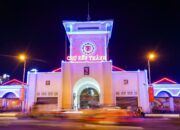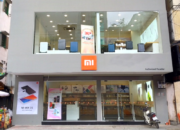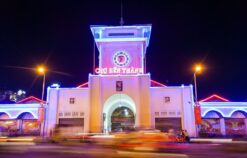USS Ancon (AGC-4) was an ocean liner acquired by the United States Navy during World War II and converted to a combined headquarters and communications command ship. Ancon anchored off Fedhala, French Morocco on November 8 and began lowering her boats at 0533. The first troops were debarked an hour later. During the course of […]
USS Ancon (AGC-4) was an ocean liner acquired by the United States Navy during World War II and converted to a combined headquarters and communications command ship.
Ancon anchored off Fedhala, French Morocco on November 8 and began lowering her boats at 0533. The first troops were debarked an hour later. During the course of the assault, men on the ship witnessed the sinking of four other transports, and Ancon sent out boats to rescue their survivors. On November 12 the transport headed out and, three days later, put into Casablanca harbor. She got underway on the 15th with a convoy bound for Norfolk.
After a brief pause there, Ancon traveled to Brooklyn, New York for voyage repairs. A brief period of sea trials preceded the ship’s loading cargo and troops for transportation to Algeria. She sailed on January 14, 1943 as a member of the Naval Transport Service. The ship reached Oran on the 26th and spent five days discharging her cargo before heading back toward New York City, where she arrived on February 13. On that day, the vessel was reassigned to the Atlantic Fleet Amphibious Forces. On the 16th, Ancon entered the Norfolk Navy Yard, Portsmouth, Virginia, to undergo conversion to a combined headquarters and communications command ship. She was redesignated AGC-4 on February 26.
Following the completion of the yard work on April 21, Ancon held trials and exercises in the Chesapeake Bay through May and into early June when she was designated the flagship of the Commander of the Atlantic Fleet Amphibious Forces. The ship got underway for Oran on June 8 with Task Force (TF) 85. The ship had been selected to participate in the invasion of Sicily, and her preparations continued after her arrival at Oran on June 22.
Carrying Rear Admiral Alan G. Kirk, Commander, TF 85, and Lieutenant General Omar Bradley on board, Ancon sailed on July 5 for the waters off Sicily. She reached the transport area off Scoglitti on the 10th and lowered her boats early that morning. Despite enemy fire, the ship remained off Scoglitti providing communications services through the 12th and then got underway to return to North Africa. At the end of a fortnight there, she shifted to Mostaganem, Algeria, on July 29. In mid-August, the vessel moved to Algiers. During her periods in port, she prepared for the upcoming invasion of mainland Italy for which she had been designated flagship for the Commander of the 8th Fleet Amphibious Forces in Northwest African Waters.
On September 6, Ancon got underway for Salerno. During the operation, the ship carried Lieutenant General Mark Wayne Clark who commanded the 5th Army. At 0330 on September 9, the first wave of Allied troops hit the beach. Thereafter, she remained in the transport area, undergoing nearly continuous enemy air harassment, until she moved to Palermo, Sicily, to pick up ammunition to replenish her sister ships. She returned to the area off Salerno on the 15th but, the next day, arrived back in Palermo.
After two weeks in that Sicilian port, Ancon shaped a course for Algiers. She reached that port on October 2 and spent almost six weeks undergoing repairs and replenishment. In mid-November, she set sail for the United Kingdom and, on November 25, arrived in Devonport, England, where she was designated the flagship of the 11th Amphibious Force. An extended period of repairs and preparations for the impending invasion of France kept Ancon occupied through the winter and much of the spring participating in numerous training exercises with other Allied warships. On May 25, King George VI of the United Kingdom and Field Marshal Bernard Law Montgomery visited the ship.
The preparations culminated on June 5, when Ancon got underway for Baie de la Seine, France. She served as flagship for the assault forces that landed on Omaha Beach in Normandy. Throughout the invasion, the ship provided instructions for forces both afloat and ashore. She transferred various units of the Army command to headquarters ashore and made her small boats available to other ships to carry personnel and materials to the beachhead. On June 27, she got underway to return to England and, the next day, arrived at Portland.
Ancon remained in British waters through late September, when she sailed in a convoy bound for the East Coast of the United States. She reached Charleston, South Carolina on October 9 and was then assigned to the Amphibious Training Command. At the completion of repairs at the Charleston Navy Yard on December 21, the ship got underway for sea trials. Five days later, she shaped a course for the Pacific. On the last day of 1944, the ship transited the Panama Canal and joined the Pacific Fleet. She continued on to San Diego, California, where she arrived on January 9, 1945.
Tham Khảo chuyên mục khác:
– Camnangcuocsong.edu.vn
– Du lịch
– Món ngon


















